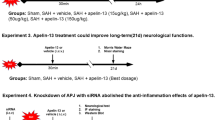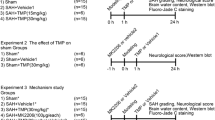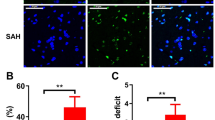Abstract
Background
Early brain injury (EBI) has been considered as the major contributor to the neurological dysfunction and poor clinical outcomes of subarachnoid hemorrhage (SAH). Studies showed that apelin-13 exhibits a neuroprotective effect in brain damage induced by cerebral ischemia. However, it remains unclear whether apelin-13 could exhibit the protective functions following SAH. The present study aimed to validate the neuroprotective role of apelin-13 in SAH, and further investigated the underlying mechanisms.
Methods and results
We constructed SAH rat model and we found that apelin-13 significantly alleviated neurological disorder and brain edema, improved memory deficits in SAH rats. Apelin-13 treatment decreased contents of TNF-α and IL-1β in cerebral spinal fluid of SAH rat by using ELISA. Apelin-13 treatment promoted the expression of APJ and Bcl-2, and decreased the level of active caspase-3 and Bax in the temporal cortex after SAH by using western blot. Also, apelin-13 attenuated the cortical cell death and neuronal degeneration as shown by TUNEL, FJB and Nissl staining. However, ML221, an inhibitor of APJ, significantly reversed all the above neuroprotective effects of apelin-13. Moreover, a neuron-microglia co-culture system, which mimic SAH in vitro, confirmed the protective effect of apelin-13 on neurons and the inhibitory effect on inflammation through apoptosis-related proteins.
Conclusions
These data demonstrated that apelin-13 exhibit a neuroprotective role after SAH through inhibition of apoptosis in an APJ dependent manner.





Similar content being viewed by others
Abbreviations
- ANOVA:
-
Analysis of variance
- APJ:
-
G protein-coupled receptor-apelin and angiotensin-1-like receptor
- Bax:
-
Bcl-2 associated x protein
- Bcl-2:
-
B-cell lymphoma 2
- CSF:
-
Cerebral spinal fluid
- DAPI:
-
4′,6-Diamidino-2-phenylindole
- DMSO:
-
Dimethylsulfoxide
- dUTP:
-
2′-Deoxyuridine 5′-Triphosphate
- EBI:
-
Early brain injury
- ER:
-
Endoplasmic reticulum
- FJB:
-
Fluoro-Jade B
- GLP-1R/PI3K/Akt:
-
Glucagon-like peptide-1/phosphatidylinositol 3-kinase/protein kinase B
- IL-1β:
-
Interleukin-1β
- PBS:
-
Phosphate buffer solution
- ML221:
-
4-Oxo-6-((pyrimidin-2-ylthio)methyl)-4H-pyran-3-yl 4-nitrobenzoate
- MWM:
-
Morris water maze
- Nrf2:
-
Nuclear factor erythroid 2-related factor-2
- ROS:
-
Reactive oxide species
- SAH:
-
Subarachnoid hemorrhage
- SD:
-
Sprague–Dawley
- TNF-α:
-
Tumor necrosis factor-α
- WW/DW:
-
Wet weight/dry weight
- Means ± SD:
-
Means ± standard deviation
- IF:
-
Immunofluorescence
- MTT:
-
3-(4,5-Dimethylthiazol-2-yl)-2,5-diphenyltetrazolium bromide
References
Macdonald RL, Schweizer TA (2017) Spontaneous subarachnoid haemorrhage. Lancet 389:655–666. https://doi.org/10.1016/S0140-6736(16)30668-7
Balbi M, Vega MJ, Lourbopoulos A et al (2019) Long-term impairment of neurovascular coupling following experimental subarachnoid hemorrhage. J Cereb Blood Flow Metab. https://doi.org/10.1177/0271678X19863021
Suzuki H (2019) Inflammation: a good research target to improve outcomes of poor-grade subarachnoid hemorrhage. Transl Stroke Res 10:597–600. https://doi.org/10.1007/s12975-019-00713-y
Mejdoubi M, Schertz M, Zanolla S et al (2018) Transoceanic management and treatment of aneurysmal subarachnoid hemorrhage: a 10-year experience. Stroke 49:127–132. https://doi.org/10.1161/STROKEAHA.117.017436
Xie YK, Zhou X, Yuan HT et al (2019) Resveratrol reduces brain injury after subarachnoid hemorrhage by inhibiting oxidative stress and endoplasmic reticulum stress. Neural Regen Res 14:1734–1742. https://doi.org/10.4103/1673-5374.257529
Conzen C, Becker K, Albanna W et al (2019) The acute phase of experimental subarachnoid hemorrhage: intracranial pressure dynamics and their effect on cerebral blood flow and autoregulation. Transl Stroke Res 10:566–582. https://doi.org/10.1007/s12975-018-0674-3
Naraoka M, Fumoto T, Li Y et al (2019) The role of intracranial pressure and subarachnoid blood clots in early brain injury after experimental subarachnoid hemorrhage in rats. World Neurosurg 129:e63–e72. https://doi.org/10.1016/j.wneu.2019.05.009
Kleinz MJ, Davenport AP (2005) Emerging roles of apelin in biology and medicine. Pharmacol Ther 107:198–211. https://doi.org/10.1016/j.pharmthera.2005.04.001
Bao H, Yang X, Huang Y et al (2016) The neuroprotective effect of apelin-13 in a mouse model of intracerebral hemorrhage. Neurosci Lett 628:219–224. https://doi.org/10.1016/j.neulet.2016.06.046
Duan J, Cui J, Yang Z et al (2019) Neuroprotective effect of Apelin 13 on ischemic stroke by activating AMPK/GSK-3beta/Nrf2 signaling. J Neuroinflamm 16:24. https://doi.org/10.1186/s12974-019-1406-7
Tian X, Sun L, Feng D et al (2017) HMGB1 promotes neurovascular remodeling via rage in the late phase of subarachnoid hemorrhage. Brain Res 1670:135–145. https://doi.org/10.1016/j.brainres.2017.06.001
Yang Y, Zhang X, Cui H et al (2014) Apelin-13 protects the brain against ischemia/reperfusion injury through activating PI3K/Akt and ERK1/2 signaling pathways. Neurosci Lett 568:44–49. https://doi.org/10.1016/j.neulet.2014.03.037
Xiong Q, He W, Wang H et al (2017) Effect of the spinal apelinAPJ system on the pathogenesis of chronic constriction injuryinduced neuropathic pain in rats. Mol Med Rep 16:1223–1231. https://doi.org/10.3892/mmr.2017.6734
Zhang Z, Wu Y, Yuan S et al (2018) Glutathione peroxidase 4 participates in secondary brain injury through mediating ferroptosis in a rat model of intracerebral hemorrhage. Brain Res 1701:112–125. https://doi.org/10.1016/j.brainres.2018.09.012
Li P, Li X, Deng P et al (2020) Activation of adenosine A3 receptor reduces early brain injury by alleviating neuroinflammation after subarachnoid hemorrhage in elderly rats. Aging 13:694–713. https://doi.org/10.18632/aging.202178
Angelopoulou E, Paudel YN, Bougea A et al (2021) Impact of the apelin/APJ axis in the pathogenesis of Parkinson’s disease with therapeutic potential. J Neurosci Res. https://doi.org/10.1002/jnr.24895
O’Donnell LA, Agrawal A, Sabnekar P et al (2007) Apelin, an endogenous neuronal peptide, protects hippocampal neurons against excitotoxic injury. J Neurochem 102:1905–1917. https://doi.org/10.1111/j.1471-4159.2007.04645.x
Xu W, Gao L, Li T et al (2018) Apelin-13 alleviates early brain injury after subarachnoid hemorrhage via suppression of endoplasmic reticulum stress-mediated apoptosis and blood-brain barrier disruption: possible involvement of ATF6/CHOP pathway. Neuroscience 388:284–296. https://doi.org/10.1016/j.neuroscience.2018.07.023
Liu Y, Zhang T, Wang Y et al (2019) Apelin-13 attenuates early brain injury following subarachnoid hemorrhage via suppressing neuronal apoptosis through the GLP-1R/PI3K/Akt signaling. Biochem Biophys Res Commun 513:105–111. https://doi.org/10.1016/j.bbrc.2019.03.151
Xu W, Li T, Gao L et al (2019) Apelin-13/APJ system attenuates early brain injury via suppression of endoplasmic reticulum stress-associated TXNIP/NLRP3 inflammasome activation and oxidative stress in a AMPK-dependent manner after subarachnoid hemorrhage in rats. J Neuroinflamm 16:247. https://doi.org/10.1186/s12974-019-1620-3
Roche J, Rame C, Reverchon M et al (2017) Apelin (APLN) regulates progesterone secretion and oocyte maturation in bovine ovarian cells. Reproduction 153:589–603. https://doi.org/10.1530/REP-16-0677
Datta A, Sarmah D, Mounica L et al (2020) Cell death pathways in ischemic stroke and targeted pharmacotherapy. Transl Stroke Res. https://doi.org/10.1007/s12975-020-00806-z
Aminyavari S, Zahmatkesh M, Farahmandfar M et al (2019) Protective role of Apelin-13 on amyloid beta25-35-induced memory deficit; involvement of autophagy and apoptosis process. Prog Neuropsychopharmacol Biol Psychiatry 89:322–334. https://doi.org/10.1016/j.pnpbp.2018.10.005
Zou Y, Wang B, Fu W et al (2016) Apelin-13 protects PC12 cells from corticosterone-induced apoptosis through PI3K and ERKs activation. Neurochem Res 41:1635–1644. https://doi.org/10.1007/s11064-016-1878-0
Acknowledgements
The authors thank Mr. Zhi Li for his linguistic assistance during the preparation of this manuscript.
Funding
This work was supported by the National Natural Science Foundation of China (Nos. 81873741 & 82071297).
Author information
Authors and Affiliations
Contributions
All authors had full access to all the data in the study and take responsibility for the integrity of the data and the accuracy of the data analysis. Study concept and design: GC, ZW and HS. Acquisition of data: XS, and GY. Analysis and interpretation of data: BL, CC, DC, and JW. Drafting manuscript: XS, and GY. Administrative, technical, and material support: HL, and XL. Study supervision: GC, ZW and HS.
Corresponding authors
Ethics declarations
Conflict of interests
The authors declare that they have no conflict of interests.
Ethical approval
All animal experiments were approved by the Institutional Animal Care Committee of Soochow University and were performed in accordance with the guidelines of the National Institutes of Health.
Additional information
Publisher's Note
Springer Nature remains neutral with regard to jurisdictional claims in published maps and institutional affiliations.
Supplementary Information
Below is the link to the electronic supplementary material.
11033_2021_7028_MOESM3_ESM.tif
Supplementary file3 (TIF 22704 KB) Supplemental Fig 1. The morphological changes observation of neuron and BV-2 cells in different groups.
11033_2021_7028_MOESM4_ESM.tif
Supplementary file4 (TIF 442 KB) Supplemental Fig 2. The viability of neuron and BV-2 cells in different groups was detected by MTT assay. *P < 0.05, **P < 0.01, ns P > 0.05.
Rights and permissions
About this article
Cite this article
Shen, X., Yuan, G., Li, B. et al. Apelin-13 attenuates early brain injury through inhibiting inflammation and apoptosis in rats after experimental subarachnoid hemorrhage. Mol Biol Rep 49, 2107–2118 (2022). https://doi.org/10.1007/s11033-021-07028-y
Received:
Accepted:
Published:
Issue Date:
DOI: https://doi.org/10.1007/s11033-021-07028-y




